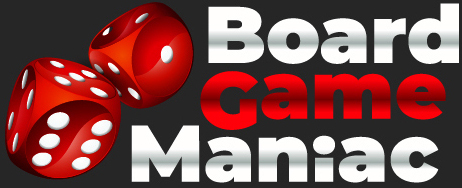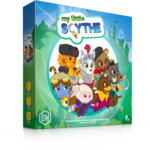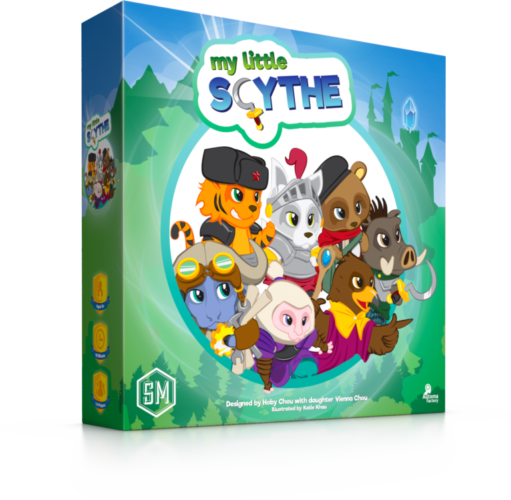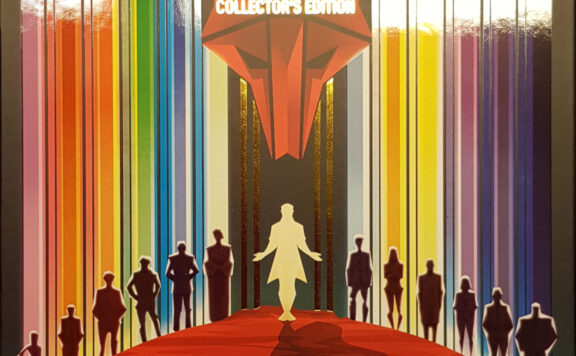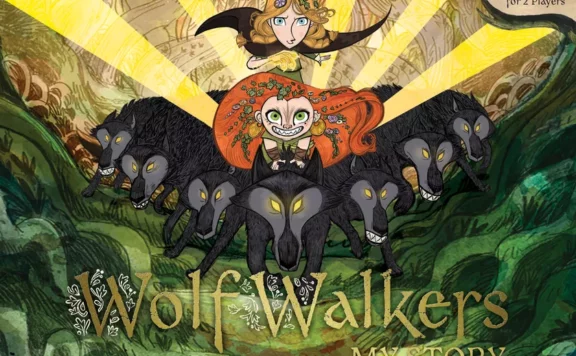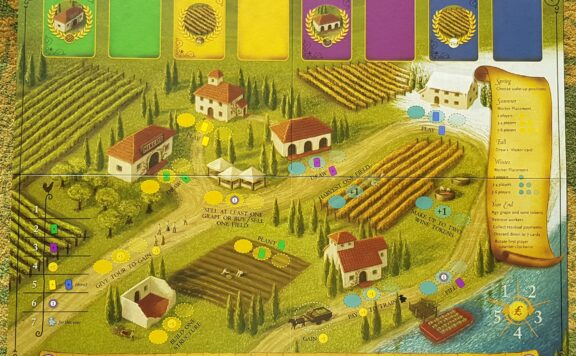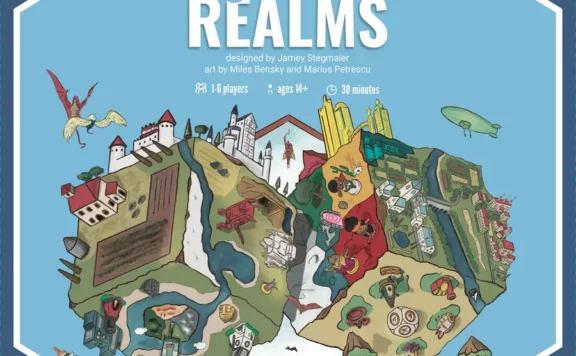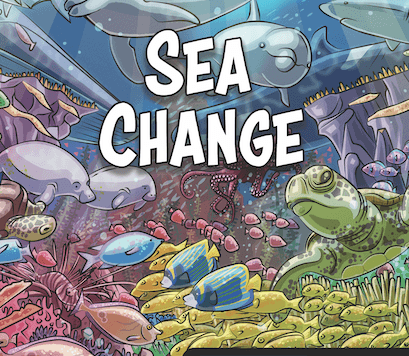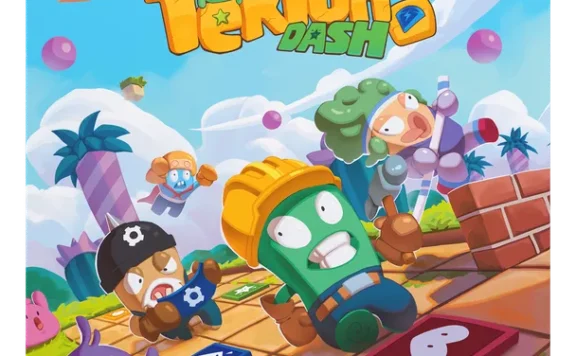It’s a rare case, when a board game for adults is re-designed to produce a kids-friendly version. Scythe has been a huge hit since its publication in 2016 and most of us were so captivated by its amazing story and immersive world that we wished we could play that with our kids. However, the complexity of the game as well as its duration hindered us from doing so. Yet, Hoby Chou had another idea. He decided to try and combine the love of his sweet little daughter, Vienna, for board games and My Little Ponny with his affection to Scythe. And that was the beginning of all for My Little Scythe (I’ll call it MLS from now on for the sake of brevity). If you want to read more about the relation Scythe has with My Little Scythe, you can jump to the section called “Relation to Scythe”.
Here is a brief presentation of the game, but if you know all about that, you can skip it and jump to our scoring categories below.
MLS is a game for 1 to 6 players (yes, it can also be played solo) and lasts about 45 minutes. The game takes place in the fantastic kingdom of Pomme, full of magic and all kinds of animals that live in peace, spread in 7 animal kingdoms. Each year, each kingdom sends 2 of its most promising sibling Seekers to take part in the Harvest Tournament. The first pair that wins 4 trophies, is crowned the new rulers of Pomme.
Players earn trophies when meeting the following criteria:
- reach 8 pies on the pie track
- reach 8 friendship on the friendship track
- deliver 4 apples to castle Evergreen
- deliver 4 gems to castle Evergreen
- win a pie fight
- have one of each of Power-up tiles
- complete 2 quests
- have 3 magic spells
During setup, players must first choose an animal kingdom and take the 2 animal Seeker siblings miniatures that were chosen to represent it in the tournament. They start out from their camp base, the location of which will vary according to the number of players. Each player is given a personality card, which will help towards gaining a specific trophy. Some initial resources are put on the board (apples, gems and quest tokens) and the game is ready to start.
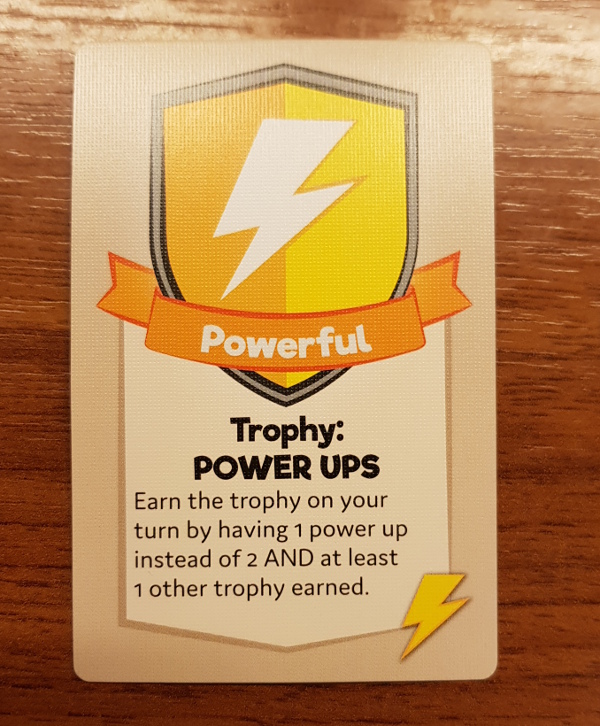
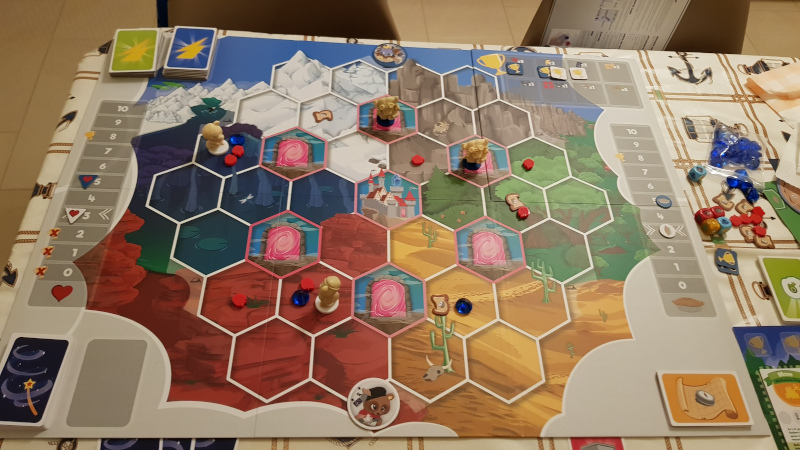
Each player has a player mat which displays the 3 available actions a player may choose from, during his/her turn. Only one action may be chosen and it can’t be the same as the previous one. The available actions are:
- Move: Each sibling may move up to 2 spaces when not carrying resources and up to 1 space when carrying resources
- Seek: Special dice are thrown to determine where new resources will appear on the map. Dice determine the region in which resources will appear, but the player must choose the exact hex in that region where he/she will put the resources.
- Make: Players may use apples to make pies, magic gems to make magic spells or an apple and a gem to gain a power up tile that will improve the Move or Make action
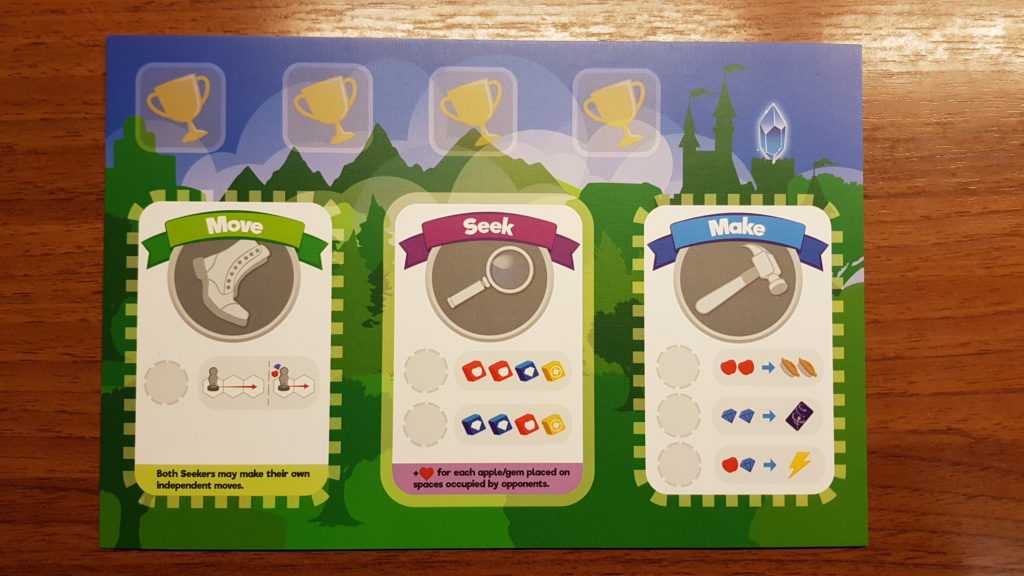
Whenever a Seeker steps into a space occupied by an opponent’s Seeker, the attacking player will loose 1 friendship and a piefight will begin. Fighting players will simultaneously and secretly choose, how many pies to throw to one another (limited by the players’ total number of pies shown on the pie track) and optionally add a magic spell for each of their Seekers involved in the fight. To secretly choose the number of pies, players use the special Pie fight dials. Upon losing a fight, the defeated Seeker goes back to its Camp Base and is rejuvenated by gaining 2 pies or a magic spell.
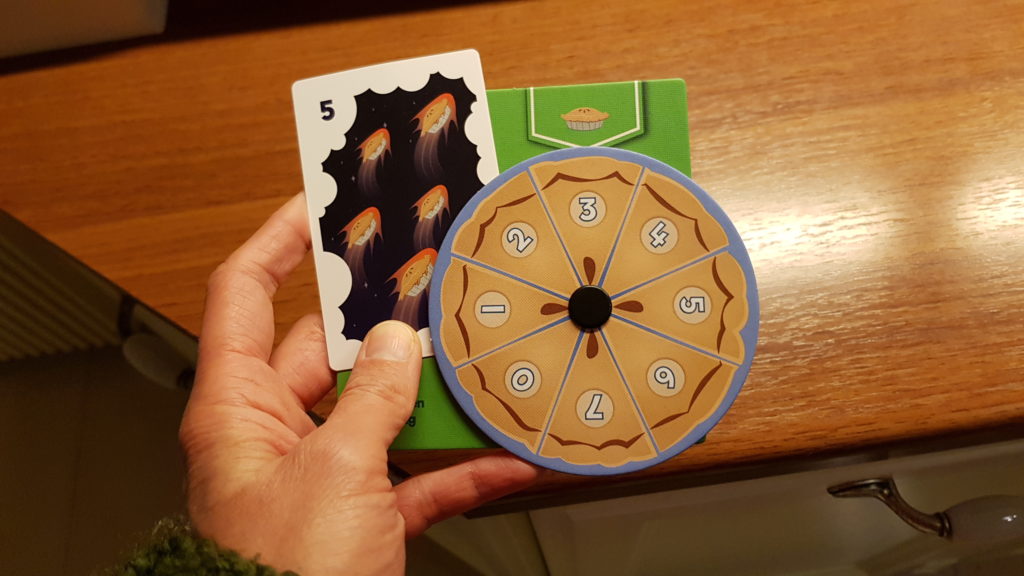
A player cannot earn trophies if his/her friendship level is below 3.
At the end of the turn in which a player has gained his 4th trophy, the Grand Finale begins and all players not having 4 trophies have one last turn as a last chance to earn more trophies. The player with 4 trophies is then crowned the winner and new ruler of Pomme. If multiple players have 4 trophies, ties are resolved in a number of ways.
Now let’s go on and see how the game scores in our usual scoring categories:
Components
When I first saw the big box of the game and as much as I was looking forward to see what’s inside, I couldn’t help standing there and just staring at the cover for a while, smiling. The artwork of these cute animals , so colorful and strong, immediately grasps you and you feel totally prepared to enter a fantastic world. I think many kids will want to play MLS just by taking a look at the box, even if they know nothing about the game.
Stonemaier Games has always spoiled us, with the quality of components of every game published. That is why I had big expectations when I was about to finally open the big box. And when I did, a had the most pleasant surprise. In the box there was a custom insert, one of those beautiful trays you usually buy as an extra for better organization of the various tits and bits a board game has. But there it was, already included in the game, making me feel that this company really treats its customers with great respect. It actually is a multi-layered tray with 2 trays, one for minis and the other for everything else and in-between them the folded gameboard, as seen in the image below. Everything fits perfectly in there and it makes setup and cleanup really quick. There is also room for an upcoming expansion in the bottom tray, as well as in the miniatures tray.
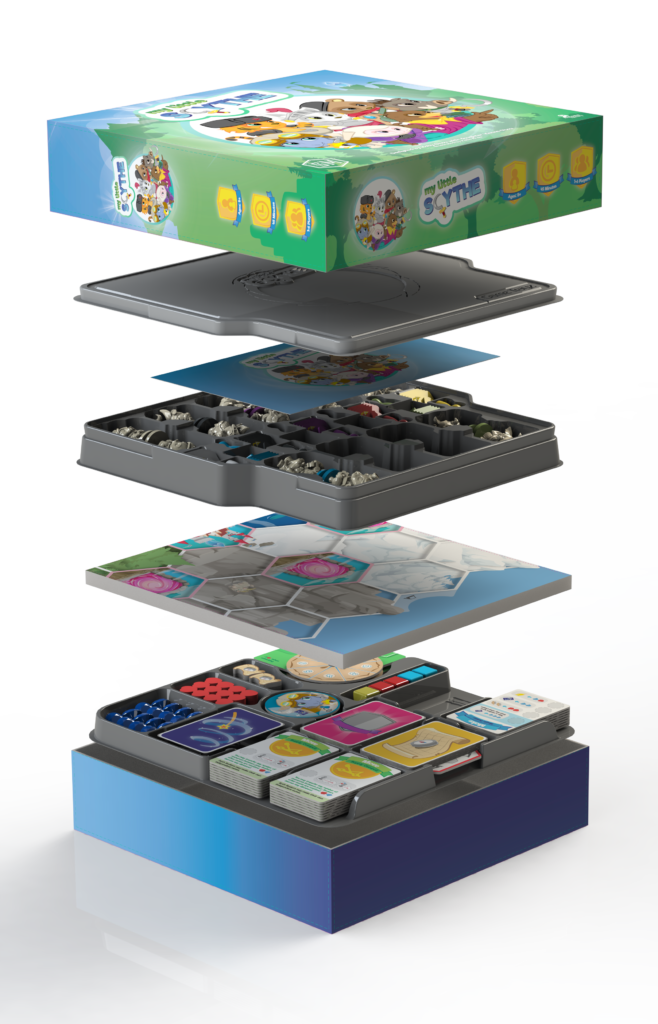
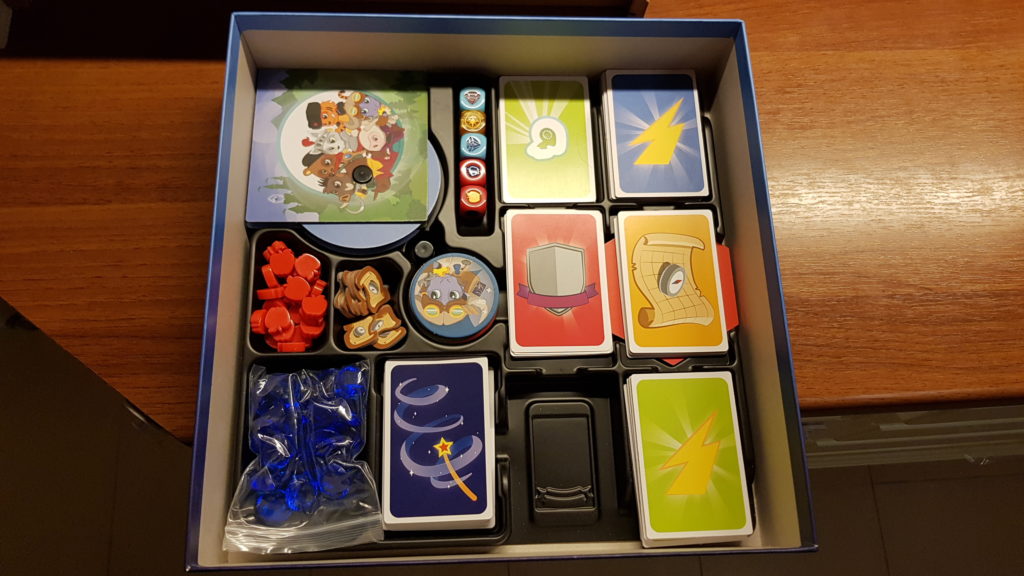
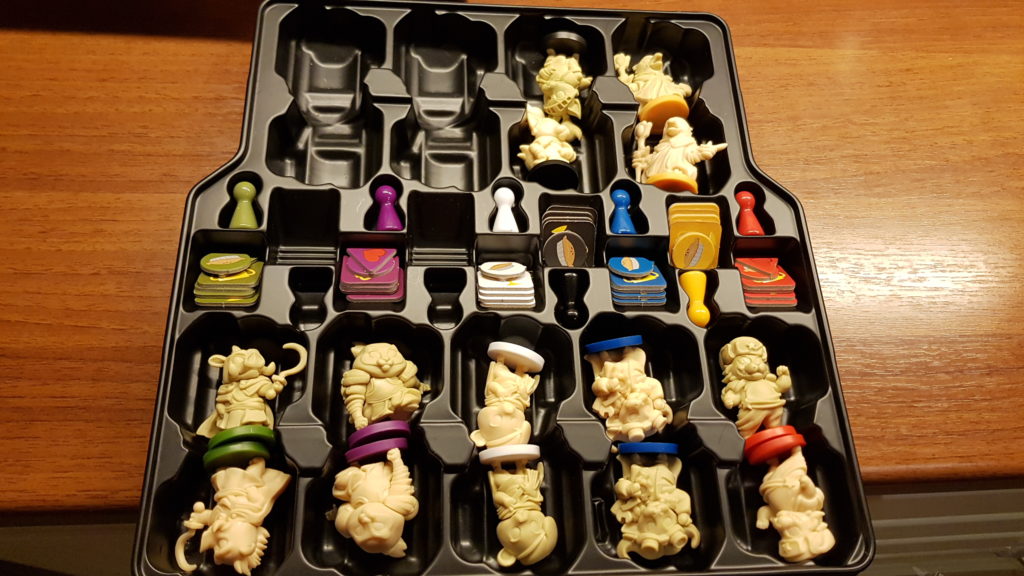
The 14 miniatures of the animal creatures also deserve a special mention as they are very detailed and super cute. If you are into painting, of course, it’s a must to color them and there is also a painting guide for doing so if you lack inspiration. I have never painted a mini and i think i don’t have the patience to do so, so I guess maybe i’ll have them painted by a professional at some point. However I wish they were pre-painted and that is a general whine about games with minis in general. For people who know how to do it and have an artistic soul, I guess it’s better to paint them themselves, but what percentage are they, against the vast majority of board gamers?
Did I mention that the gameboard is really huge? I haven’t quite realized just how huge, by looking at photos of the game beforehand but when I unfolded it, it pretty much covered almost all of my playtest area. So be aware: you need quite a lot of space to play this game. In some cases I’ve been playing the game on the floor and it’s quite fun and comfortable for the kids as well. Such a big gameboard is a delight for the eyes, especially those of little kids. The hex tiles where Seekers travel, are big enough for little hands to be able to move around the minis without requiring precision.
All other components of the game are of equal good quality. Apples and gems are plastic and power up cards are made of very thick cardboard. The rest of the cards and tokens are made of high-quality cardboard. The custom dice of the game, used to distribute new resources on the map, are also beautiful, with engraved symbols of the game’s resources on them.
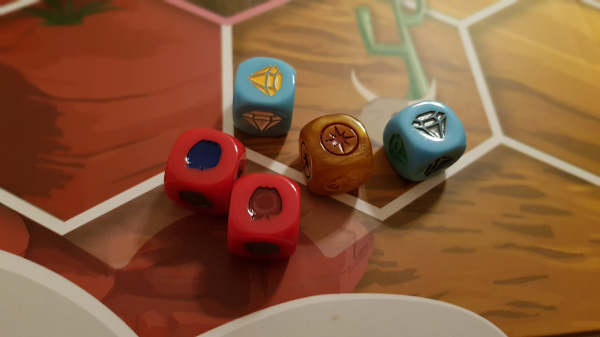
Overall, components are, as expected from Stonemaier Games, of top-notch quality and well above typical standards. 9/10
Gameplay
MLS has a quick setup as well as cleanup time, which is partly achieved due to the amazing custom tray where you can find everything quickly. When kids are involved this is pretty important so they don’t lose interest but adults will also appreciate it.
Players have to make important decisions throughout the game without that causing a headache. When moving for example, an important decision is to choose whether to take resources with you or not. Another important decision, with great impact to the course of the game, is how to distribute new resources put on the map with the “Seek” action.
The variety of trophies that can be earned, may at first cause some confusion especially to the young players because they will not know where to focus. But by playing and trying to pursuit a number of different trophies, they will gradually find out what style of play suits their personality and what trophies are the most fun for them to pursue. My personal favorite and the one I usually go for first, is the Power-ups trophy.
Player interaction is present in this game in 3 ways:
- The most obvious one is Pie Fights. Just the idea of throwing pies to one another gets you excited and its implementation really produces a lot of fun. Getting into fights constantly won’t lead you anywhere near winning, because it lowers your friendship level and makes it difficult to earn trophies. This is a smart design trick in order to achieve a balanced gameplay.
- The second way to interact with other players is through quests. Quests have 3 options: the first one presents a benefit only for you whereas the second benefits you while simultaneously hurting an opponent. However you have to pay for such a dirty trick, usually by lowering your friendship level. The third option is to just visit the place, gain a small benefit and put the card back.
- Finally, the 3rd way to interact with players is during the Seek action, when you get to choose where to put new resources on the board. You have the option to put a resource (apple or gem) at a hex occupied by an opponent, thus increasing your friendship level. This is a move, you probably wouldn’t want to make, except if you are after the friendship trophy or your friendship level has dropped below 3. I think the more players you play with, the more you will use this option because with many players you can aid a player who is behind in winning trophies, but in a 2-player game or solo play, you wouldn’t want to aid your sole opponent.
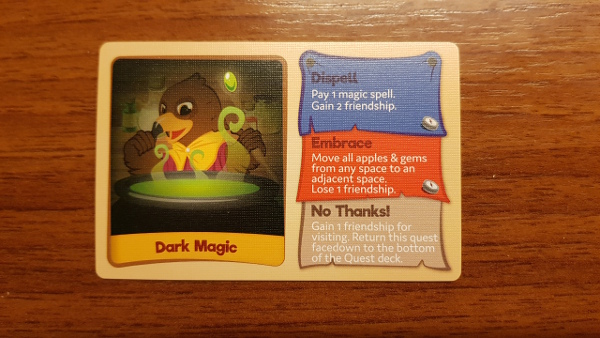
I was eager to try the solo mode as it would help me further playtest the game, following my own pace of play. I was pleasantly surprised by 2 things regarding Automountie (this is the name of the A.I. opponent in this game) : the simplicity of rules that define how she plays and the balance in gameplay which is achieved by these rules. Automountie does not have a personality card or a player board, she does not complete quests or use power ups but, to balance that, she wins a trophy merely by having in her possession a specific number of apples, gems and quest tokens at the start of each of her turns. There are 5 levels of difficulty to choose from when using Automountie and you can also play with more than one A.I. opponent or even team up with your kid against one or more Automounties. The 5 difficulty levels are: Very Easy, Easy, Normal, Hard and Very Hard. I started out with the Normal mode which means that Automountie needs to gather 4 resources to gain a trophy and starts with 3 pies, like a normal player. I have won the second time I tried and immediately after that, I was eager to go to the next level. The Hard level proved to be just that, an opponent hard to beat (I am still trying to win this one). Automountie plays her turn pretty fast (a bit quicker I think, compared to a normal player). It is clear that many hours must have been spent, programming and testing this artificial opponent. I had a great time playing the solo mode and I’ll keep on trying to beat the hard levels.
Overall, My Little Scythe has a gameplay easy enough for young players to understand while also engaging and strategic to keep them involved. It’s also attractive to adult gamers, making it an ideal game within families or friends looking for a simple yet challenging game. 8/10
Learning Curve
Although the game has rich gameplay, it is pretty easy to teach due to the clean mechanisms involved. Seekers have only 3 distinctive actions to choose from, the details of each being depicted with detail on the player board. Pie fights have also simple rules and in general there is not much info that one must know by heart in order to play the game. The rulebook is very well written and clarifies any question that may arise during play. The Automa rules are also pretty simple. 8/10
Theme
The question that arises here is “When playing My Little Scythe, do you feel that you are travelling in a fantastic, magical world ?”. “Do you feel that you are taking part in a tournament and compete for trophies”? Well, the gameboard with its colorful depiction of the different regions of Pomme (tundra, forest, mountains, swamp, red rock and desert) helps a lot towards getting immersed in the game’s world and so do the detailed miniatures of the animals. 7/10
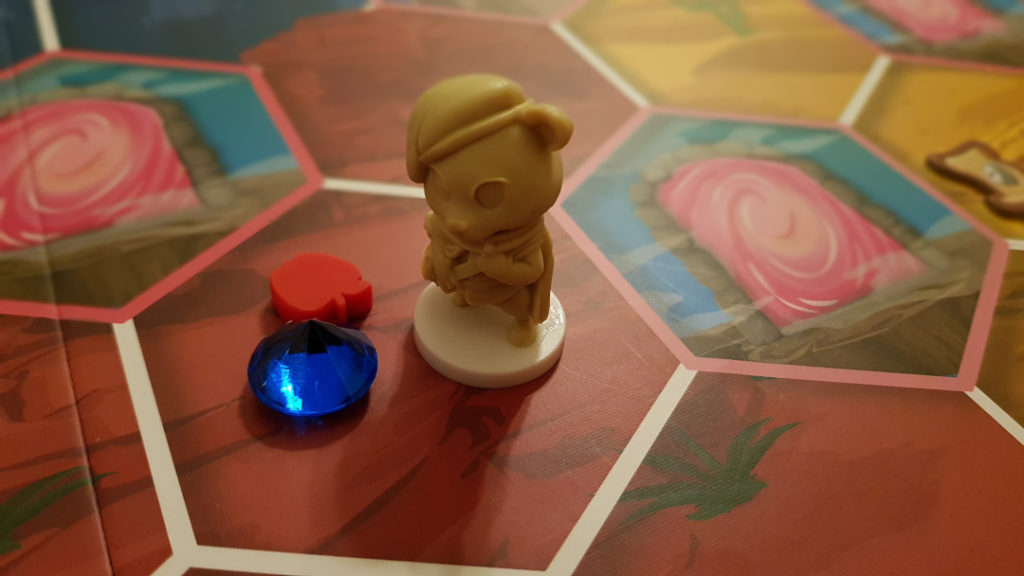
Replayability
The simple rules of the game, depth of gameplay and beautiful components makes me want to comeback for more. Included in the box is also an achievement sheet, with many different achievements you can try to accomplish (such as the first player to win each month, the first player of each kingdom to win a game e.t.c.). That certainly raises replayability.
In case you can’t find any opponent or in order to have a more rich gameplay, especially in 2-player games, you can also try the solo mode or the team mode against Automounties which presents a big challenge in high levels of difficulty. Kids can also enjoy the solo mode, beginning with the easiest level of difficulty and gradually setting a higher goal.
The game is suited for kids aged 8+ as designated on the box but I decided to give it a try with my 4-year old son. He was thrilled by the huge, bright-colored gameboard and the minis but wasn’t able to stay interested until the end of the game. I guess I was expecting too much from him. Still, the next day, he wanted to play again and that is definitely a good sign for the replayability factor of the game. Painting the minis with the kids can also be much fun. 8/10
Fun
Fun is very important especially if we are talking about a kids game. There are many aspects of MLS that produce fun and these are:
- the first that comes to mind is of course the Pie fights! I like imitating a real pie fight when resolving this one
- controlling and moving around those cute little animals
- the huge colorful gameboard
- trying to earn trophies
- player interaction
- painting the minis
8/10
Educational value
This is a new scoring category, that will be assessed for children’s games only and will have a significant weight in relation to the other scoring categories as I think it’s an important aspect in choosing the right game for your child.
Kids have a lot to learn by playing MLS. First of all they learn how to be organized, how to handle their resources with care and how to make important decisions that will have an impact in the future. From trial and error, they can adopt certain strategies of winning and feel more confident by doing so.
Moreover, there is a certain aspect of the game that will teach them something valuable: the vanity of confrontations. When they decide to be involved in many pie fights (however fun that is) they will realize they cannot earn trophies because their friendship level will drop by each fight. The tournament judges are not fond of troublemakers and punish them by not letting them win a trophy if their friendship level is below 3. This is a way of letting kids know that hostility leads nowhere and no progress can be really made when fighting with each other. I like the subtle way this lesson is presented in MLS.
When playing with a kid, you have the option to play not against each other, but form a team to beat one or more A.I. opponents. That has a double advantage. Confrontations are avoided and kids have the opportunity to learn how to cooperate in order to achieve a common goal. 8/10
Relation to Scythe
My Little Scythe and Scythe have a lot to share in terms of mechanics and gameplay in general. Most of the elements of gameplay in Scythe where altered in order to be kid-friendly in MLS. I have assembled the following comparison table with the most important alterations between the two:
| My Little Scythe | Scythe |
|---|---|
| Game set in alternate-history 1920s | Game set in a fantastic kingdom |
| Players represent a character from a faction | Players control animals from a fantastic kingdom |
| The goal of the game is to gather the most coins | The goal of the game is to gather the most trophys |
| Players gather metal, food, oil, wood and workers | Players gather apples and gems |
| 4 different kind of actions (each with an additional bottom-row action) : Bolster, Produce, Move and Trade | 3 different actions: Move, Seek, Make (no bottom-row actions) |
| Players engage in combat | Players engage in pie fights |
| Combat cards | Magic spell cards |
| Players have encounters | Players complete quests |
| In the center of the gameboard lies The Factory | In the center of the gameboard lies Castle Evergreen |
Final Verdict
My Little Scythe is practically a game for all ages. It has simple but deep gameplay, beautiful and high quality components and is a lot of fun to play. It has much to offer to kids, besides fun, as it enhances organisation skills ,encourages strategic thinking and collaboration and teaches them the futility of being hostile. Adults will also have a lot of fun playing the game, especially Scythe fans who love the mechanisms of the former but would like a quicker and simpler game. The solo mode is excellently designed and creates a whole lot of new challenges and the opportunity to play collaborately (team play against one or more Automounties), which boosts replayability.
Recommended for: everyone
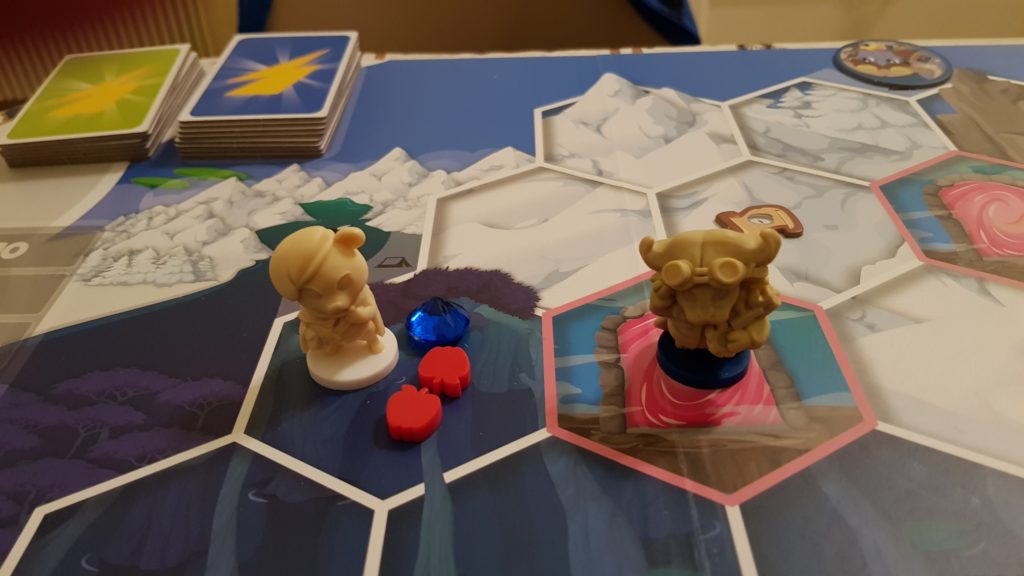
According to our scoring system for children’s games, scoring categories have different weights. Components have 9% weight, Gameplay 21%, Learning curve 3%, Theme 2%, Replayability 15%, Fun 25%, Educational Value 25%. According to this system and the above scoring in each category, overall weighted scoring of the game is:
Overall: 8.10
If you like this game, you can buy it from the link below along with other games from Stonemaier Games :
If you’d like to learn more about Scythe, you can read our review, here.
